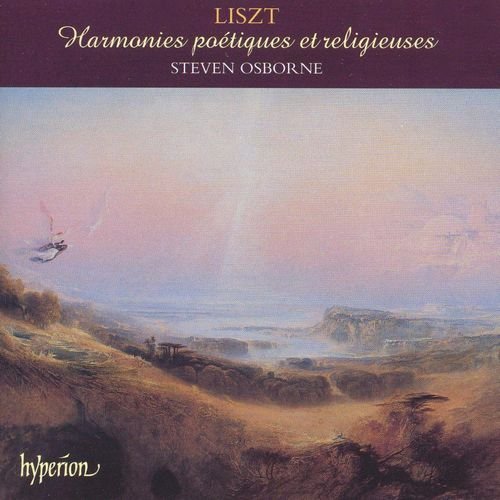Steven Osborne - Franz Liszt - Harmonies poétiques et religieuses (2004)

Artist: Steven Osborne
Title: Franz Liszt - Harmonies poétiques et religieuses
Year Of Release: 2004
Label: Hyperion
Genre: Classical
Quality: FLAC (tracks+.cue,log,scans)
Total Time: 01:23:44
Total Size: 217 Mb
WebSite: Album Preview
Tracklist: Title: Franz Liszt - Harmonies poétiques et religieuses
Year Of Release: 2004
Label: Hyperion
Genre: Classical
Quality: FLAC (tracks+.cue,log,scans)
Total Time: 01:23:44
Total Size: 217 Mb
WebSite: Album Preview
CD 1:
01. I Invocation (7:31)
02. II Ave Maria (5:59)
03. III Bénédiction de Dieu dans la solitude (17:15)
04. IV Pensée des morts (13:52)
05. V Pater noster (2:36)
CD 2:
01. VI Hymne de l’Enfant à son réveil (7:21)
02. VII Funérailles (12:05)
03. VIII Miserere d’après Palestrina (3:05)
04. IX [Andante lagrimoso] (7:54)
05. X Cantique d’amour (6:07)
Performers:
Steven Osborne (piano)
Anticipating the developments of his maturity, Franz Liszt's Harmonies poétiques et religieuses is an important transitional piece, if not especially coherent or profound. Liszt's sentimentality and chronic showmanship prevent this set of pious reveries from achieving the deepest spiritual dimensions. But there are many reflective moments in this work that indicate a growing seriousness and even presage the dark emotions and austerity of his final period. While the Invocation, Bénédiction de Dieu dans la solitude, and the Cantique d'amour are predictably ecstatic in their climaxes, each contains sustained passages of calm introspection. Liszt's transcriptions of his choral works -- Ave Maria, Pater noster, and the Hymne de l'enfant à son réveil -- along with the Miserere, d'après Palestrina are comparatively unembellished and striking in their purity. Liszt's religiosity dominates Harmonies, but he offsets it with three poetic musings on sorrow and death. The Pensée des morts, Funérailles, and the Andante lagrimoso are surprisingly stark and subdued, and look forward to the muted late piano works. In Steven Osborne's thoughtful interpretations, Liszt's excesses are somewhat minimized and his subtleties are solidly reinforced. Osborne's low-key approach may seem antithetical to Liszt -- perhaps too Chopin-esque -- but the results are at least tasteful and often more intriguing than a flashier reading would permit.



![Ben Paterson - Live at the Jazz Showcase (Live at the Jazz Showcase, 2025) (2025) [Hi-Res] Ben Paterson - Live at the Jazz Showcase (Live at the Jazz Showcase, 2025) (2025) [Hi-Res]](https://www.dibpic.com/uploads/posts/2025-12/1764918893_i7jlseprubwbb_600.jpg)
![Florian Pellissier Quintet - Pacifiques Biches (2025) [Hi-Res] Florian Pellissier Quintet - Pacifiques Biches (2025) [Hi-Res]](https://www.dibpic.com/uploads/posts/2025-12/1764901939_ozvzpfzp1icdb_600.jpg)
![Kit Sebastian - New Internationale (Deluxe Edition) (2025) [Hi-Res] Kit Sebastian - New Internationale (Deluxe Edition) (2025) [Hi-Res]](https://www.dibpic.com/uploads/posts/2025-12/1764882405_os4lt15ji5k0g_600.jpg)

![Keiko Matsui - Wildflower (2004) [CDRip] Keiko Matsui - Wildflower (2004) [CDRip]](https://www.dibpic.com/uploads/posts/2021-05/1620323036_50.jpg)
